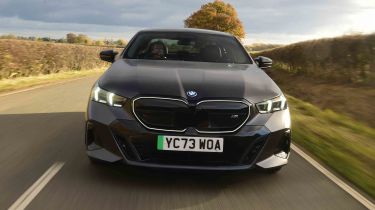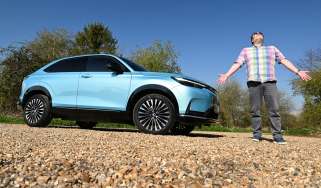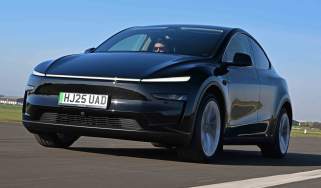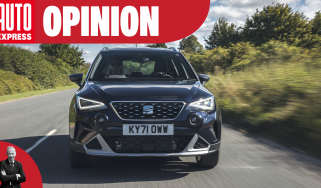BMW i5 - Range, charging & running costs
Efficiency could be better, but a large battery gives decent range, and residuals are better than rivals

During our time driving the eDrive40, we reckon you’ll more likely see 300 miles of range in the real world rather than the claimed 350 miles. The 3.1 miles/kWh efficiency figure we got from an M60 version during our Audi e-tron GT vs BMW i5 twin test suggests this model will likely need a recharge after just 250 miles. We suspect that the larger 89kWh battery pack and slippery aerodynamics of the Mercedes EQE will allow you to travel even further between charges.
You can use onboard technology to improve matters, such as the B-mode regenerative braking setting accessed via the gearlever we mentioned earlier. It slows the car when you lift off the accelerator, harvesting more energy while slowing to help top up the main battery pack. A heat pump is also included as standard, providing a more efficient way of heating the interior on a cold morning. Our best advice is to avoid the larger wheel sizes because these introduce extra rolling resistance that hurts range.
A lofty 205kW peak charging speed means a 10-80 per cent top-up (going from around 35 miles to just over 280 miles of remaining range in an eDrive40 model – depending upon the outside temperature and driving conditions) should be possible in around 30 minutes. That’s a few minutes quicker than the EQE, which has a slower 170kW maximum charging speed and a larger battery pack.
Most people will probably use the offer to install a 7kW wall box charger at home and charge the i5 using cheaper overnight electricity rates. Refilling a flat battery this way will take about 13 hours. The entry-level Sport Edition comes as standard with the £1,200 AC Charging Professional option that increases the AC charging capability up to 22kW, helping to reduce this charging time down to just over four hours. That’s handy, but you’ll need a three-phase electricity supply to power it, and most UK homes do not have such a supply.
To tempt Tesla buyers who’ve enjoyed the simplicity of the American brand’s dedicated charging network, you can utilise Plug&Charge with your i5. It allows owners to simply pull up to a compatible DC rapid charger and initialise charging without faffing around with apps or payment cards every time – provided you’ve set everything up using your My BMW app beforehand.
If all this sounds appealing, and you’ve got the means to run an i5 as a company car, a higher-rate taxpayer could save a fortune compared with a regular petrol or diesel car in Benefit in Kind (BiK) tax. The M Sport Pro and M60i versions cost a little more, but the difference won’t be all that much. Just be aware that starting from 2025, electric cars will be charged more in BiK, plus they’ll no longer be exempt from road tax or the London congestion charge.
Insurance will be costly due to an electric car's performance and high list price, but at least the eDrive40 M Sport models in group 43 should be cheaper to insure than the base-model EQE, which is in the most expensive group 50 band. The M60 model will set you back the most to insure because it's in group 49.
According to our expert depreciation data, the i5 should be worth between 47 to 50 per cent of its original value after three years and 36,000 miles. That’s a little better than the Genesis G80 Electrified, which will be worth 47 per cent, and a lot better than the Mercedes EQE which will only be worth between 35 to 41 per cent after the same period of time.
| Model | Battery size | Range | Insurance group |
| i5 eDrive40 Sport Edition | 81.2kWh | 356.7 miles | 43 |
| i5 eDrive40 M Sport Pro | 81.2kWh | 352.9 miles | 43 |
| i5 M60 xDrive | 81.2kWh | 315.7 miles | 49 |
More reviews
Which Is Best
Most Economical
- Name250kW eDrive40 Sport Edition 84kWh 4dr Auto [Tec+]
- Gearbox typeAuto
- RRP£71,755










